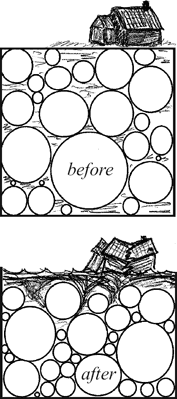Learning Benchmarks
1.3 Students will understand that interactions within and among
systems cause changes in matter and energy.
2.2 Students will also apply science knowledge and skills to
solve problems or meet challenges.
Grade Levels
6th-10th grades
Subjects
Earth Science,
Liquefaction,
Earthquakes
Concept
How different soils react during an earthquake.
Skills
Observing, comparing and contrasting, and identifying relationships.
Objective
Students will test soils’ reaction to ground shaking representing
an earthquake.
Time Needed
60 minutes or less
Discussion
1. Compare what happens to the water when using different soils;
describe what happens between water and soil for each type tested.
2. How would these differing soils affect human development, such as
structures or houses?
3. How can people plan for
earthquakes when considering a
new building location?
4. How can people plan for
earthquakes if their houses are
already in hazardous places?
5. How can people find out if their
houses are in hazardous places?
Permission is granted to photocopy this lesson. There is no copyright.
Simple Home Experiments for Bringing Geology to Life
Experiment 1: SHAKE, RATTLE, AND Liquefy
Background:When sediments liquefy, they lose their structure and strength. During earthquake shaking, the individual grains of sand within a deposit collapse on each other. Anything built on them can sink or collapse. Picture a container of balls of slightly different sizes–baseballs, golfballs, marbles. If they were transported by water into the container and then deposited, they would settle with spaces between them. Some of the spaces would be filled with water, some with air. When you shake the container, the balls settle against each other, and the water and air are forced to the surface. That is exactly what happens in a sediment-filled valley. The valley is a large ‘container’ holding gazillions of ‘balls’ or grains of sand. Shaking the container simulates an earthquake.
 Equipment needed:
Equipment needed:
- Transparent (glass) baking pan
- Enough dry sand to fill your pan 1 to 2 inches
- A few toy houses or wooden blocks
- Water
Purpose:
We know that flat river valley bottoms
are prone to flooding, but we often think of them as
being geologically stable. This experiment will teach
you what happens to sandy soils when they liquefy. It
will show you how to create a ‘model’ river valley,
then watch how and why houses get damaged or collapse
during an earthquake in a seemingly stable geologic
environment.
Procedure:
- Evenly pour the dry sand into the baking pan.
- Mark the level of the sand on the side of the pan.
- Place the houses or blocks gently on the surface.
- Slowly add water until about two-thirds of the thickness of the sand is saturated.
- Gently start shaking the table on which you have placed your baking pan (or the pan itself).
Observations:
You should see the following:
- The water will work its way to the surface, flooding the area around the houses,
- The houses will start leaning over and sinking into the sand, and
- The volume of the sand should decrease by a small amount.
Expanded Activity:
Now be creative. Try the experiment using clay or gravel to
separate sand layers and represent different types of sedimentary layers. Watch what happens
to the water and the surface of your model of a river valley.
Credits:
Wendy Gerstel, Geologist
Washington Division of Geology and Earth Resources